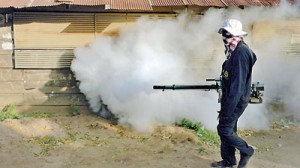News
Dengue infections soaring inland amid floods, drought destruction
View(s):Deadly dengue is spreading rapidly in the interiors of the island, health officials warn.
Central Province Health Services Director, Dr. Shanthi Samarasinghe, the told the Sunday Times hospitals in Kandy and Peradeniya have witnessed greater numbers of patients.
“We treat all fever patients as potential dengue cases as a preventive measure,’’ she said. Special units will be set up to treat dengue.
She said uncollected garbage is contributing to the dengue crisis.
“A toffee wrapper is sufficient to spread dengue in your locality. People also have to change their attitudes,’’ she said.
Following the deadly flooding in Ratnapura, 3,599 dengue cases have been reported, recent updates by the Epidemiology Unit, show.
An official at the provincial health department, said the highest number of cases were reported from the Ratnapura town and from Kuruwita. Six people have died in six months.
The flooding disrupted dengue control activities, but cleaning campaigns and spraying of insecticide have begun. Dengue cases are expected to increase further. Hospitals in Ratnapura are also filling up.
Batticaloa, which is facing severe drought, has reported 3,664 dengue cases this year. The increase in cases in February, March, and April was unusual for the district.
Dr Dharshini Kantharuban, the regional epidemiologist of Batticaloa, said one to two patients are admitted to hospitals every day. A sustainable solution had not been found, so far, she said.
She said garbage collection is done in the district along with regular dengue-control activities. Jaffna, yet another district that is baking in the drought, is admitting four to five dengue patients a day.
The consultant community physician of the Northern Province, Dr R. Kesavan, said transmission of dengue within the district is minimal. And the dry weather which has minimised mosquito breeding places, is a contributing factor. But he said dengue control activities are continuing.
| Hambantota: 400 dengue patients this year; 890 whole of last year Hambantota District Health Services Director, Dr. Chamal Sanjeeva said the number of dengue patients in the district has skyrocketed with 1,430 cases reported during the first five months of this year. According to Dr. Sanjeeva, 400 dengue patients had been recorded from the Tissamaharama MOH (Medical Officer of Health) Division, 177 from the Hambantota MOH Division, 112 from the Ambalantota MOH Division and 118 from the Tangalle MOH Division.  Pic by Rahul Samantha Hettiarachchi The situation contrasts sharply with the 890 patients recorded from the entire Hambantota District last year. He added that authorities had conducted dengue prevention and fogging programmes in collaboration with government and non government organisations in a bid to bring the situation under control.
| |

